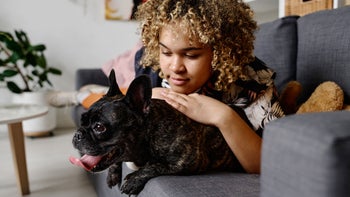
Dog Obesity: How to Help Your Dog Lose Weight
Key takeaways:
By increasing the risk for health conditions like diabetes and arthritis, obesity can have a significant and long-term impact on your dog's health.
There are many ways that you can help your dog safely lose weight, including switching their food, feeding them fewer treats, and helping them get more exercise.
Your vet can determine the cause of your dog’s obesity and suggest the best strategies to get them to a healthy dog weight.
Table of contents
It’s not uncommon for dogs to be overweight. Nearly 60% of dogs in the U.S. were overweight in 2022. Unfortunately, obesity can lead to serious health issues for dogs.
If your dog needs to lose weight, there are plenty of things you can do to help them shed pounds. It will require some work and time, but your dog will be healthier and more comfortable in the end.
How to help a dog lose weight
If your dog is overweight, your vet can help you create a diet and exercise plan to encourage them to lose some weight. By sticking to that plan and making some simple changes to your dog’s routine, you can get your dog on a path to be healthier and happier.
Save on the top 10 pet medications
Save big on common pet medications like Fluoxetine and Levetiracetam at your local pharmacy.

GoodRx is NOT insurance. GoodRx Health information and resources are reviewed by our editorial staff with medical and healthcare policy and pricing experience. See our editorial policy for more detail. We also provide access to services offered by GoodRx and our partners when we think these services might be useful to our visitors. We may receive compensation when a user decides to leverage these services, but making them available does not influence the medical content our editorial staff provides.
Sara Ochoa, DVM, a veterinarian at the Animal Hospital of West Monroe in Louisiana, recommends nine strategies for helping dogs lose weight.
1. Feed your dog the correct amount of food
Be sure to feed your dog the correct amount of food each day. Most dog-food bags include feeding guidelines. If you are feeding your dog the recommended amount already and they are still gaining weight, Ochoa advises reducing the amount you are feeding them by 10% to 15%.
2. Stop feeding your dog treats
If your dog needs to lose weight, don’t feed them treats. Hard as it may be, treats add extra calories to your dog’s diet.
3. Take longer walks
Increasing the amount of time that your dog spends walking each day can help them lose weight. Adding in an extra game of fetch in the backyard or weekend outings to the dog park may also be in order.
4. Feed your dog a low-fat diet
Consider feeding your pup a low-fat dog food that’s designed to help them lose weight. These types of food are often high in fiber, as well as low in fat, which helps your dog feel full.
5. Move their food bowl
Play hide-and-seek with your dog’s food bowl by regularly moving it to different locations. The more your dog moves around to look for the bowl, the more calories they’ll burn.
6. Use puzzle feeders
Interactive food bowls force your dog to eat more slowly and may help them feel fuller longer.
7. Find other ways to exercise
Twice a day, spend at least 10 to 15 minutes playing with your dog. You could play fetch or chase, or even create a small obstacle course for them. Change it up every day so your pet doesn’t get bored.
8. Offer non-food rewards
Instead of giving your dog a treat or table scraps, reward them with extra praise, a belly rub, or snuggling.
9. Talk to your vet
If you’re concerned about your dog’s weight, it’s worth scheduling a visit with your vet. Your vet can examine your dog to better understand the cause of their obesity and determine a path forward.
“Usually, blood work will quickly let your vet know what is causing your dog to become overweight, and they can devise a plan to help your dog lose weight,” Ochoa said.
Keep in mind that your dog should lose weight gradually. A crash diet could lead to life-threatening liver failure, so be patient and follow the plan that your vet has developed. Your vet will likely aim for your dog to lose 1% to 5% of their body weight each month.
How much exercise does your dog need? Read about how much exercise your dog should be getting based on their breed, age, and size.
Protecting joint health: Does your pooch struggle with physical activity? They may need a joint supplement.
Can dogs have sleep apnea? Weight gain can affect your dog’s breathing and cause sleep apnea. Maintaining a healthy dog weight can help.
How to choose diet dog food
A good diet dog food reduces calories without sacrificing nutrients. Nutrients like protein and fiber are particularly important because they help dogs feel fuller longer, while promoting health. And, according to research, diets that combine a high fiber content with a high amount of protein seem to work well for weight loss.
As you search for the best dog food to lose weight, look for the following:
Protein: 25%-30% of dry matter or 10-20 gm per 1,000 calories
Fat: 5%-15% fat or 2-3.5 g per 1,000 calories
Fiber: 60 gm per 1,000 calories
If you decide to change your dog’s food, make sure you do so gradually to avoid stomach upset.
Is my dog overweight?
Checking your dog’s weight at home is pretty simple. Just follow these three steps:
Place your hands on your dog’s ribs. If you can feel their ribs without too much fat covering them, they’re probably at a healthy dog weight. If you have trouble feeling their ribs, your dog may be overweight.
Look at their chest. It should be broader than their tummy. If their midsection is the same size as their chest, they may be too heavy.
Now, glance at their body from the side. There should be a line curving up from their chest to their belly or waist. If their stomach is sagging toward the floor, your dog is probably overweight.
Using a body condition score (BCS) can help you effectively evaluate and monitor your dog’s weight. Depending on the scoring system you use, you will score your dog’s body on a scale of 1 to 5 or 1 to 9. If your dog’s score is on the higher end of the range, they may need to lose some weight.
And there are a few other signs your dog is likely overweight, according to Ochoa:
They’re having difficulty moving around.
They seem to be having more trouble breathing.
They have a big, round belly.
“About 75% of the dogs who walk into my clinic are technically overweight,” Ochoa said. “Some dogs are more obese and overweight than others, but most pets can lose a few pounds to be at their ideal body weight.”
What causes dog obesity?
There are many potential causes of canine obesity. Ochoa notes that the following causes are the most common:
Overfeeding: Many dog owners free-feed their dog, which can quickly lead to weight gain. Ochoa recommends measuring your dog’s food and feeding them the proper amount each day.
Too many treats: Don’t forget that treats contain calories, and they can cause your dog to gain weight. If you feed your dog treats, offer them low-calorie treats and don’t feed them too many.
Certain health conditions: Some health conditions can make it more difficult for dogs to maintain a health weight, regardless of diet or exercise. Cushing’s disease and hypothyroidism (when a dog’s thyroid doesn’t produce enough hormone) are two such conditions.
Lack of exercise: If your dog doesn’t get enough exercise, they will gain weight. It’s best to take your dog for at least a short walk or let them play outside each day.
Certain risk factors can also increase a dog’s chances of becoming overweight:
Age: As a dog gets older, their chances of being overweight increases.
Breed: Some breeds have lower energy needs than others, meaning their bodies store extra calories as fat instead of burning them off through activity. Certain breeds — such as cocker spaniels, dachshunds, dalmatians, golden retrievers, Labrador retrievers, rottweilers, and Shetland sheepdogs — are also more likely to put on extra weight.
Genetics: A dog may be predisposed to obesity simply because of genetics.
Sex: Obesity occurs more often in female dogs, and females who have been spayed have an even higher chance of becoming overweight.
Health problems associated with dog obesity
Dogs who are overweight are at an increased risk for many health problems, including:
Heart disease
Kidney disease
Diabetes
Skin infections
Arthritis
Breathing difficulties
Ochoa notes that obesity can have lifelong implications on your dog’s health. “Not only does being overweight cause your dog to have an increased chance of certain diseases, they can also develop arthritis and hip dysplasia that causes irreversible damage,” she said. “These issues are often lifelong, causing your dog [long-term] pain and discomfort.”
In addition to affecting the quality of your dog’s life, obesity may even shorten it. One study found that dogs who are overweight may live up to 3 years less than leaner, fitter dogs.
Preventing dog obesity
Ochoa notes that you can help prevent your dog from gaining too much weight by taking these precautions:
Ensuring your dog gets plenty of exercise
Feeding them a proper diet with proper portions
Decreasing the amount of food you give them and cutting out treats if they start to gain weight
Checking in with your vet at least once a year and anytime you notice a change in your dog’s weight or health.
The bottom line
Obesity can have serious implications for your dog’s health, but there are also many ways to help your dog lose weight. By working with your vet, you can get to the root of your dog’s obesity and find effective strategies to help them shed some pounds.
Most weight-loss plans for dogs include a combination of diet and exercise. It will take work on both your and your dog’s part, but your dog will be healthier and more comfortable once they’re at a lower weight.
Why trust our experts?



References
Armstrong, P. J. (2011). Canine obesity: Disease associations and management. World Small Animal Veterinary Association World Congress Proceedings.
Association for Pet Obesity Prevention. (2019). 2018 press release and summary of the Veterinary Clinic: Pet Obesity Prevalence Survey & Pet Owner: Weight Management, Nutrition, and Pet Food Survey.
Brooks, W. (2019). Obesity is unhealthy in dogs and cats. Veterinary Partner.
Cline, M. G., et al. (2022). 2021 AAHA nutrition and weight management guidelines for dogs and cats. Journal of the American Animal Hospital Association.
Salt, P. C., et al. (2018). Association between life span and body condition in neutered client-owned dogs. Journal of Veterinary Internal Medicine.
Shmalberg, J. (2013). Treatment of obesity in cats and dogs. Today’s Veterinary Practice.
Ward, E. (2019). The 5 biggest questions you must ask about pet obesity: How to check, what to feed, and how to exercise. Association for Pet Obesity Prevention.
Weber, M., et al. (2008). A high-protein, high-fiber diet designed for weight loss improves satiety in dogs. Journal of Veterinary Internal Medicine.

























